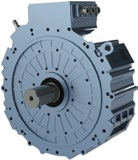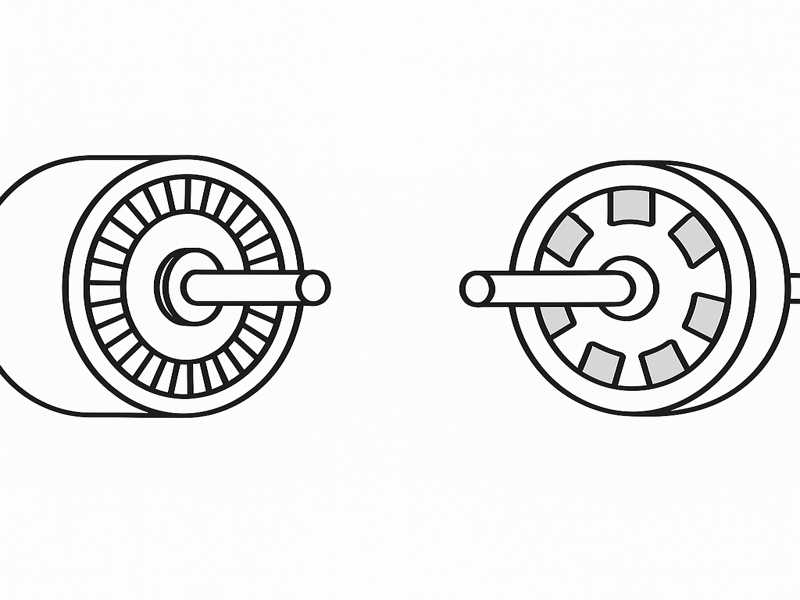In the world of electric motors, design architecture plays a crucial role in determining performance, efficiency, and suitability for different applications. Two major categories have gained significant attention—Axial Flux Motors and Radial Flux Motors.
These motors differ in the way magnetic flux flows through the stator and rotor, resulting in unique characteristics that engineers must consider when selecting a motor for a given use case.
What Is a Radial Flux Motor?
A Radial Flux Motor (RFM) is the traditional and most widely used electric motor architecture. In this design, the magnetic flux flows radially—from the center outward (or vice versa)—perpendicular to the axis of rotation. The stator surrounds the rotor, which spins on a central shaft.
Key Components
- Rotor: Cylindrical and placed inside the stator
- Stator: Houses the windings and surrounds the rotor
- Flux direction: Radial (center to edge or vice versa)
Typical Applications
- Electric vehicles (EVs)
- Household appliances
- Pumps and compressors
- Industrial automation

What Is an Axial Flux Motor?
An Axial Flux Motor (AFM), also known as a pancake or disc motor, features a different geometry. In this configuration, the magnetic flux flows parallel to the axis of rotation—from one side of the motor to the other. The rotor and stator are arranged face-to-face rather than concentrically.
Key Components
- Rotor: Flat disc-like shape, placed between or beside stator discs
- Stator: Also disc-shaped, often placed on either side of the rotor
- Flux direction: Axial (parallel to the shaft)
Typical Applications
- Aerospace propulsion systems
- E-mobility (e-bikes, scooters)
- Robotics and drones
- Compact industrial drives
Design Comparison
| Feature | Axial Flux Motor | Radial Flux Motor |
| Flux Direction | Axial (parallel to shaft) | Radial (perpendicular to shaft) |
| Shape | Disc or pancake | Cylindrical |
| Power Density | Higher (up to 30% more) | Moderate |
| Torque Density | High due to large rotor diameter | Lower than AFM |
| Cooling Efficiency | Better (shorter thermal path) | Standard |
| Size Efficiency | Compact and flat | Longer axial length |
| Manufacturing Complexity | Higher (precision assembly needed) | Easier to manufacture |
| Cost | Generally higher | Generally lower |
| Mass Production Maturity | Emerging technology | Highly mature |
| Best Suited For | Space-constrained, high torque systems | General-purpose and industrial use |

Performance Metrics: Torque, Power, and Efficiency
Torque
Axial flux motors typically deliver higher torque per unit volume than radial flux motors because of their larger effective rotor diameter. This is particularly useful in direct-drive applications.
For example:
- A high-performance axial flux motor may deliver 15 Nm/kg
- A comparable radial flux motor delivers around 10–12 Nm/kg
Power Density
The flat geometry of axial flux motors allows for up to 30–50% more power density, which is crucial in applications such as drones, e-motorcycles, or aircraft propulsion.
Efficiency
Axial flux motors can reach efficiencies of 96% or higher, especially in optimized low-speed, high-torque designs. Radial flux motors typically max out around 92–94%, although modern designs with permanent magnets are catching up.
Thermal Management and Cooling
Thermal management is a key consideration in motor design. Axial flux motors have an inherently shorter thermal path, meaning the heat generated in the windings can dissipate more effectively, especially when dual stators are used. This allows for:
- Higher continuous power output
- Better integration with water or oil cooling systems
Radial flux motors, however, are easier to cool with airflow designs due to their cylindrical casing, making them more suitable for fan-based cooling in industrial settings.
Selection Criteria for Engineers
When selecting between axial and radial flux motors, consider:
| Criteria | Recommended Choice |
| High torque in tight space | Axial Flux Motor (AFM) |
| Cost-sensitive mass production | Radial Flux Motor (RFM) |
| Proven technology & supply chain | RFM |
| Innovative design or weight-critical | AFM |
| Ease of integration in standard systems | RFM |
A high-performance electric motorcycle requires a motor under 10kg that delivers over 200 Nm torque in a compact form. An axial flux motor would be ideal due to high torque-to-weight ratio. In contrast, an industrial conveyor line where cost and uptime are critical might choose a radial flux induction motor.
Manufacturing and Scalability
While axial flux motors offer many technical advantages, their manufacturing complexity is higher:
- Alignment of the rotor and dual stator faces must be precise.
- Air gaps must be tightly controlled.
- Magnet positioning is more critical.
Radial flux motors benefit from decades of manufacturing experience, leading to:
- Lower production costs
- High reliability
- Easier supply chain integration
Manufacturers looking to scale quickly may prefer RFMs for now, while AFMs are better suited for premium, space-constrained, or high-performance applications.
Manufacturing Perspective: What We Offer
As a manufacturer, we specialize in both radial and axial flux motor cores. Our advanced stamping and lamination technologies enable precise core assemblies for:
- Axial flux motors with dual-rotor or dual-stator topologies, ensuring high torque density.
- Radial flux motors for EV traction, industrial, and servo applications, balancing performance and cost.
We use high-grade electrical steel (0.2–0.35 mm lamination thickness), automated stator winding, and custom magnet integration for optimized performance.
Design Advantages and Disadvantages
Advantages of Axial Flux Motors
- High torque density for compact applications
- Lower weight and shorter length
- Superior thermal dissipation
- Ideal for in-wheel or in-hub applications in EVs and drones
Limitations
- More challenging to manufacture
- Higher costs per unit in small volumes
- Fewer suppliers and partners
Advantages of Radial Flux Motors
- Proven technology with broad supplier base
- Cost-effective and scalable
- Easier to maintain and replace
Limitations
- Lower torque density per unit volume
- Less compact in axial direction
Applications by Industry
| Industry | Preferred Motor Type | Reason |
| Electric Vehicles | Radial (mainstream) / Axial (premium) | Radial for cost; axial for performance, e.g., in-wheel motors |
| Aerospace | Axial | Lightweight, compact, high-torque |
| Industrial Automation | Radial | Proven reliability, easier integration |
| Robotics/Drones | Axial | Weight-saving and compact design |
| E-Bikes/Scooters | Axial | Compact packaging, torque at low RPM |
| Pumps/Fans | Radial | Standard cylindrical form is well-suited |
Real-World Use Cases
Axial Flux Example: YASA Motors
YASA, a UK-based company, developed axial flux motors used in high-performance sports cars like the Koenigsegg Regera and Ferrari SF90. These motors are ultra-thin, lightweight, and highly efficient, offering torque densities over 20 Nm/kg.
Radial Flux Example: Tesla Model 3
Tesla’s Model 3 uses radial flux permanent magnet motors, optimized for manufacturing at scale and balancing efficiency with cost. The architecture is proven and integrates seamlessly with traditional cooling and control systems.
As the electric mobility industry evolves, axial flux motors are expected to play a larger role in applications where space and weight constraints dominate, including:
- eVTOL aircraft
- Compact EVs
- High-speed robotics
That said, radial flux motors will remain the standard in industrial applications due to their low cost, simplicity, and availability. Major players are also developing hybrid designs that incorporate the best of both architectures.
Innovations include:
- Solid-state stators
- 3D-printed motor parts
- Advanced composite materials to reduce weight
- Modular axial flux platforms for easy integration
Both axial flux and radial flux motors have their place in the expanding universe of electric motor applications.
- Choose axial flux when space, weight, and torque density are critical.
- Opt for radial flux when cost, availability, and reliability are priorities.
As manufacturers, we continue to innovate in both domains—offering tailored motor solutions for clients in automotive, aerospace, robotics, and industrial automation. Whether you’re building the next generation of electric cars or compact automation systems, selecting the right motor architecture is the first step toward performance and success.

